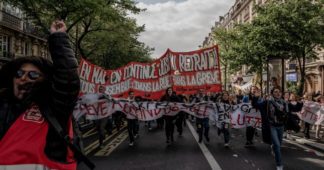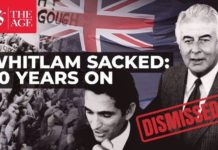Oct 29, 2025
In 1975 the ruling class in Australia conspired to subvert parliamentary democracy and sack the Labor government. Jean Parker discusses why they did it and the response
Fifty years on, 11 November 1975 remains one of the most controversial and turbulent days in Australian history.
It’s the day Gough Whitlam, the leader of a reforming Labor government that had, since being elected in 1972, formally ended White Australia, ended conscription, founded Medicare and introduced free university education, was sacked by the unelected representative of the Queen of England—the Australian Governor-General, Sir John Kerr.
The Dismissal of the Whitlam government showed that the ruling class is prepared to dispense with democratic institutions when they feel their power and wealth is threatened. Three tools were harnessed to get rid of the Labor government—the media, the Senate, and the Governor-General.
Historians and political pundits are obsessed with the story of the Dismissal from above—how Kerr kept Malcolm Fraser hidden in Government House while he handed Whitlam his letter of dismissal. What (then) Prince Charles knew of Kerr’s plans, and whether the CIA had a hand in events (it didn’t).
But the hidden history from below is essential to understanding the events surrounding Whitlam’s sacking. It shows how events that became a severe blow to the left and the working class could have been so very different.
Whitlam’s reforms were only possible because of the preceding tide of social movement and union power that brought him to office. Whitlam legislated equal pay for women, no-fault divorce, created the Racial Discrimination Act, the NT Land Rights Act, removed all university fees, ended military conscription, built childcare centres and sewerage systems to western Sydney, and granted independence to PNG.
Whitlam’s reforms changed the lives of millions of working people. The contrast with the neoliberal wasteland of Albanese’s agenda could not be starker.
The 1960s and 1970s saw the explosion of struggles for Aboriginal rights, women’s rights, and mass movement in solidarity with the Vietnamese resistance and against US imperialism. Whitlam’s reforms were only possible in a society where campaigners and militant unions—from those that led the Clarrie O’Shea general strike to those that organised the Vietnam Moratoriums—had spent decades organising.
Although sections of Australia’s elite never fully accepted the legitimacy of the new Labor government, overall, the ruling class regarded Whitlam’s reforms as a necessary release-valve after the stifling conservatism of 23 years of Liberal Party rule and the social conflicts of the period.
This had changed by 1975. The 1973/74 OPEC “oil shock” saw oil prices rise by 300 per cent. This was the catalyst for a recession that doubled unemployment as bosses shed workers and threatened factory closures. Inflation also doubled to 13 per cent.
For the first time in 30 years, instead of expanding global markets and assured profits, the corporate elite panicked as they faced gluts, sell-offs and closures.
The recession signalled the end of the global post-war boom, and the beginning of a neoliberal era of declining profit-rates, financial instability and chronic economic crises.
Australia’s corporate leaders looked to Canberra desperate for a government that would muzzle the unions, and cut back public spending to maintain their profits.
Constitutional crisis
Whitlam was re-elected in 1974, but the ruling class became determined to get Labor out. The trigger would be using the Senate to block supply, thereby cutting off the money supply to the government—for the first and only time in Australian history.
After first refusing to pass the budget in August 1975, on 16 October, Liberal leader Malcolm Fraser announced that the Liberals were committed to blocking supply; the appropriation bills would never be passed. This meant Whitlam had just 30 days’ funding before the public sector would grind to a halt. The constitutional time-bomb was ticking.
The media whipped up a sense of crisis that backed up the Liberals. Rupert Murdoch’s media empire, which had supported Labor’s election in 1972, now waged an unrelenting destabilisation campaign and began to agitate for Whitlam’s sacking by the Governor-General.
John Kerr had been appointed Governor-General by Whitlam himself. But with the crisis over supply and growing speculation about the constitutional ability of the Governor-General to break the impasse, Kerr feared that Whitlam might dismiss him. To prevent this Kerr prepared to act in concert with Fraser to sack Whitlam.
Despite warnings, like a deer caught in the headlights, Whitlam continued to act as if parliamentary conventions would be upheld. Once sacked, Whitlam accepted that Fraser was now the caretaker Prime Minister and new elections would be held.
Could Whitlam’s government have been saved?
While the ruling class used the media, the limitations of Australia’s parliamentary system and the constitution to trash the elected government, the working class saw the attack both as an attack on their elected government and more fundamentally on their own rights and conditions.
By the start of 1975 Whitlam was not only hated by the bosses, he was also increasingly unpopular with workers and the left. His government had moved sharply to the right after the 1974 Labor Conference, which has been described as a “pro-business orgy”. Labor planned to dramatically cut budget spending and mounted an ideological attack on “dole bludgers”.
Labor governments had always set out to serve capitalism. But this rightward shift marked the beginning of a fundamental break from any commitment to deliver significant reforms towards accommodating to and managing the system; an approach that has characterised every Labor government since.
Despite Whitlam’s shift to the right, workers recognised the class nature of Fraser’s sabotage campaign. From the day the Liberals first blocked supply, 16 October, mass protests and strikes began across the country. Starting with thousands of public servants and other unionists gathering outside Parliament House, the next day saw walk-offs from Brisbane construction sites and a 5000-strong rally.
The following week saw more union action and demonstrations; 15,000 in Melbourne on 20 October, 10,000 in Sydney on 24 October, and a 24-hour strike on the Fremantle docks. Within ten days 50,000 workers had attended rallies across the country, and over 100,000 had taken strike action in defence of the government. And Whitlam had not even been sacked yet.
As the industrial action and mobilisation escalated, public opinion began to shift, putting real pressure on the Liberals to pass supply. A poll taken on 30 October showed that 70 per cent wanted the Liberals to pass supply, including 41 per cent who had voted Liberal at the last election. Whitlam’s popularity had also grown by 10 per cent whereas Fraser’s fell from 64 per cent in July to 34 per cent in November.
The ruling class had tossed aside the accepted norms of parliamentary democracy and come for Whitlam by replacing Labor Senate seats vacated by retirement or death with conservatives, blocking supply and a wild propaganda campaign. But the working class response of strikes and demonstrations held the very real possibility of escalation into a social crisis that challenged the existing power structures.
Grassroots struggle created a pole of united political action among workers that regarded Fraser as a class threat in a way that Whitlam and his ministers could never do. Workers’ action pulled the professional workers and the middle class behind them, and they created fear among the reactionary small and big business owners that the unions would paralyse society.
The threat of further escalation up-ending the status-quo was so powerful that several Liberal Senators later revealed that, under pressure from their constituents, they were on the verge of crossing the floor to pass Labor’s budget. Only one vote was needed to break the deadlock. But Fraser kept them in line with the Governor-General poised to act.
As news of the government’s sacking spread on 11 November, workers spontaneously downed tools across the country. Thousands walked out in Canberra and converged at Parliament House looking for direction on how to reverse the coup and restore their government. But none came.
Across the country there were more strikes, demonstrations and calls for a general strike. But “Save your anger for the ballot box” was the message coming from Whitlam and the ACTU. This determination to plough the militancy of supporters into a “business-as-usual” election campaign meant that the grassroots momentum was squandered.
Off the streets and isolated at home, workers were subjected to a relentless media campaign that blamed Labor for the chaos and disruption. John Kerr and the Liberals had trashed the idea that governments were elected by the people.
Democracy itself was being pushed aside by an unelected Governor-General. However the message from Labor was not to mobilise the working class power to challenge the system, but to wait for another election! Fraser won the 1975 election in a landslide.
The experience has left Labor permanently scarred. While lip-service is paid to the Whitlam government and Albanese still waves his green Medicare card, the universal understanding was not about the limitations of parliamentary democracy, but that Whitlam had gone “too far, too fast”, and that should never be repeated.
Despite the odd slogan—Kevin Rudd called climate “the great moral challenge of our generation”; Anthony Albanese says “no one will be left behind”—every Labor government since Whitlam has been concerned to manage Australian capitalism, not reform it.
Fifty years later the rules and traditions of liberal democracy are fraying internationally as sections of the ruling class look to more authoritarian forms of rule.
In Whitlam’s Dismissal we can see how easily the ruling class can set aside the constitutional and parliamentary systems that normally serve them. But the hidden history of Whitlam’s Dismissal also teaches us how workers can create a counter-power that can ultimately overcome the power of the media and the bosses.
It also teaches us that if such power is to be effective, revolutionaries need to create the networks that can take people beyond the limits of union and parliamentary leaders and offer a way forward in times when millions move into struggle.
.
We remind our readers that publication of articles on our site does not mean that we agree with what is written. Our policy is to publish anything which we consider of interest, so as to assist our readers in forming their opinions. Sometimes we even publish articles with which we totally disagree, since we believe it is important for our readers to be informed on as wide a spectrum of views as possible.











